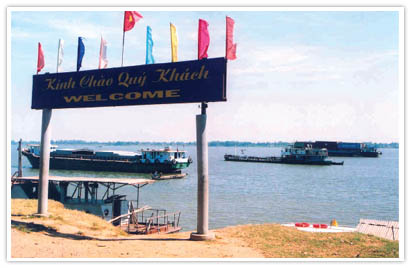Opening up the great Mekong highway
The Mekong River has always been the people's highway. A vital artery linking six countries, it has been used as a prime source of transport since people first settled in the Mekong River Basin, but the real potential of commercial shipping has rarely been used.
There have always been risks with navigating the river and today, with larger, more powerful, craft plying the river, the risks are even greater.

The new navigation agreements will facilitate
cross border procedures in
places such as the Viet Nam-Cambodia border.
Natural hazards like rocks and rapids can only be negotiated by those who are familiar with the river. Often these skills are passed down through the generations so in some regions only a handful of skilled skippers have intimate knowledge of shallows, sandbars, whirlpools and rapids and even the most experienced sailors do not travel at night. The result is that the economic potential of the river is being seriously under exploited.
In Cambodia exporters who could save money and ship more goods (particularly garments from the flourishing garment industry) from Phnom Penh to the deep sea ports in Viet Nam, or directly to the mother ports such as Hong Kong and Singapore, are halted in their tracks by only being able to sail during the day.
As shippers cannot provide a reliable service, container transport is only undertaken by a few companies.
Although the research and statistical figures clearly show that moving goods and people along the waterways is more economical and more environmentally friendly, it is not always possible for those who wish to use this type of transport to make the most of their waterways.
The Mekong River Commission's Navigation Programme (NAP) is working to change this state of affairs. In November 2006 the newly operational programme commenced a project to increase the efficiency of domestic and crossborder waterborne transport in the LMB by improving the navigation conditions on the Mekong River in the Delta between Phnom Penh, Cambodia and the border with Viet Nam by the installation of a system of aids to navigation. These buoys, beacons and shore marks, will facilitate river traffic for inland traffic between Cambodia and Viet Nam and for sea going vessels between overseas ports and Cambodia and Viet Nam.
The "Procurement, Installation and Training on Aids to Navigation on the Mekong River between the Phnom Penh Port and the Cambodia-Viet Nam border" project will provide, for the first time, a full day and night system of channel markers on the busiest stretch of the Mekong river in Cambodia.
The installation of this internationally recognised system of aids to navigation such as buoys, beacons and shore marks, aims to improve safety and efficiency of navigation so that sea-going vessels and inland barges can navigate for 24 hours per day in a safe way. As this will increase possible sailing time by 11 hours, it will allow for a rapid increase in trade from Cambodia. Previous experiences have shown that installing proper navigational aids will boost traffic by 35 per cent and this increased trade will help the country meet its goals of alleviating poverty.
It will also increase safety on the river. The lack of aids to navigation is the main cause of various accidents from collisions, ships running aground, and risks for pollution, threatening the ecosystem of the river. Prevention of accidents is a high priority for the MRC for simple reason that millions of riparians depend largely on the resources of the Mekong for drinking water, to support aquatic life and for irrigation and a polluting accident poses a serious threat to their livelihoods.
As the quality of waterborne transport improves, the waiting times will be shortened, night navigation will be possible, and river transportation will be more cost-effective and efficient. In turn, shipping forwarders and insurance fees will become less.
The 12-month project is being implemented by the Australian Maritime System Ltd (AMS) in cooperation with Phnom Penh Autonomous Port (PPAP) and the Waterways Department (WD) of the Ministry of Public Works and Transport. PPAP will be involved in the land-based operations (installation of landbased markers, storing and handling the buoys), and the WD in the water-based operations (surveys and installation). The Cambodia National Mekong Committee will act as the Coordinating Agency within Cambodia, while the MRC has overall responsibility over the project.


Two of the types of buoys being installed
between Phnom Penh and the Viet Nam border.
This project will form a basis for new commitments and closer cooperation between Cambodia and Viet Nam to aim for improvement of international navigation on the Mekong estuarine system between the sea and Phnom Penh, and open up for more trade opportunities between Cambodia and Viet Nam.
It will also make the Mekong a more reliable waterway and therefore more attractive for regional and international traders, freight forwarders, investors and shipping agencies to use it as a gateway to the larger Mekong Region.
MRC is also considering improving the navigation conditions on the Upper Mekong River in the Lao PDR and Thailand between Luang Prabang and Vientiane by possible installation of aids to navigation which would facilitate river traffic in Lao PDR, and between Lao PDR and Thailand.
In line with these physical works, MRC is also working on the legal aspects by facilitating a navigation protocol for cross border transportation between Cambodia and Viet Nam. Implementation of such a protocol will abolish all nonphysical obstructions and also boost confidence for investors.
Choose a newsletter: